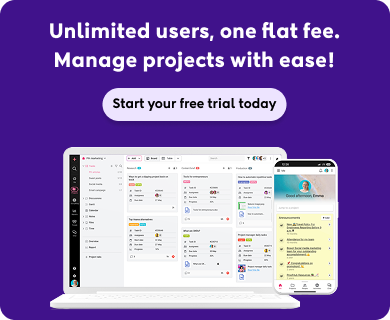The surveys from the Project Management Institute and KPMG depict the importance of successful projects to strategic commercial goals, highlighting the role of Project Portfolio Management (PPM) in delivering those projects.
This article digs a little deeper into PPM and putting together project management and project portfolio management that would ultimately mean doing the right projects right. Agile portfolio management takes the concept of build-measure-learn cycles used by agile teams for greater success. Agile Portfolio Management employs an Agile mindset for business to add value to their results:
- Shorter releases
- Reprioritize when needed
- Highly transparent
- A mindset of continuous improvement
- More productive
- Happier people
Suppose, your organization has got 45 projects on the go, and they’re all overlapping because of any random reasons. As a project manager, how do you make a good decision? How do you know if your team is focusing on the right things? What should you really be doing? How can you focus our resources most efficiently? And many more questions come into mind.
Project portfolio management (PPM) enables us to answer these questions to successfully implement PPM to achieve the greatest returns from projects.
What is portfolio management in project management?
A portfolio is a generic term used for a grouping of things. It can be a collection of assets, products, and other items depending on the industry. A portfolio in project management includes other project related activities and responsibilities. The purpose of a portfolio is to set centralized management for many projects and/or program and to make sure that you are taking on the right projects that align with the company’s values, strategies, and goals.
According to the results of the annual Project and Portfolio Management Landscape survey:
- 73% of organizations don’t have enough resources to meet the demand
- 55% of organizations state that their projects and resources are not well aligned with business goals
- 49% have gone through a project failure in the past 12 months
Project portfolio management (PPM) is a holistic management strategy used to align an organization’s software, portfolios, and projects for analysis and collaboration. Project portfolio management gives organizations and managers the ability to see the big picture. Let’s see how?
- As an executive, you’ll know which project managers to reach
- As a project manager, you’ll have easy access to team members
- The team members will have improved communication
- The stakeholders will be in the loop with consistent feedback
Keep your priorities straight and your goals in sight. Sign up here for free ProofHub trial.
What is the difference between portfolio management and project management?
According to project manager Bob Buttrick, project management is about executing ‘projects right’, portfolio management is about executing the ‘right projects’.
Project management and portfolio management are quite different. As you know project management is the application of knowledge, skills, tools, and techniques to project activities in order to meet project requirements. On the other hand Portfolio Management is a portfolio.
“Portfolio” in project management
A project portfolio is a combination of projects and programs grouped to achieve strategic objectives. There can be one or several portfolios in a project. According to PMI and its PMBOK Guide, a portfolio includes, “Projects, programs, other portfolios, and operations managed as a group to achieve strategic objectives.”
The PMO( Project Management Office) is a group defined in large organizations where project managers work in or with a group that defines standards for how projects are managed within the organization.
What is the purpose of project portfolio management?
Here are some common objectives behind the implementation of a PPM initiative in an organization:
- Maximization of value by selecting and effectively allocating resources to the projects of greatest value.
- Achieving balance by ensuring that an appropriate combination of projects is selected. For example, selecting high-risk/low-risk projects along with long term/short-term projects.
Ensuring strategic alignment by checking that every individual project contributes to the overall business strategy.
The primary goal of the PMO in an organization:
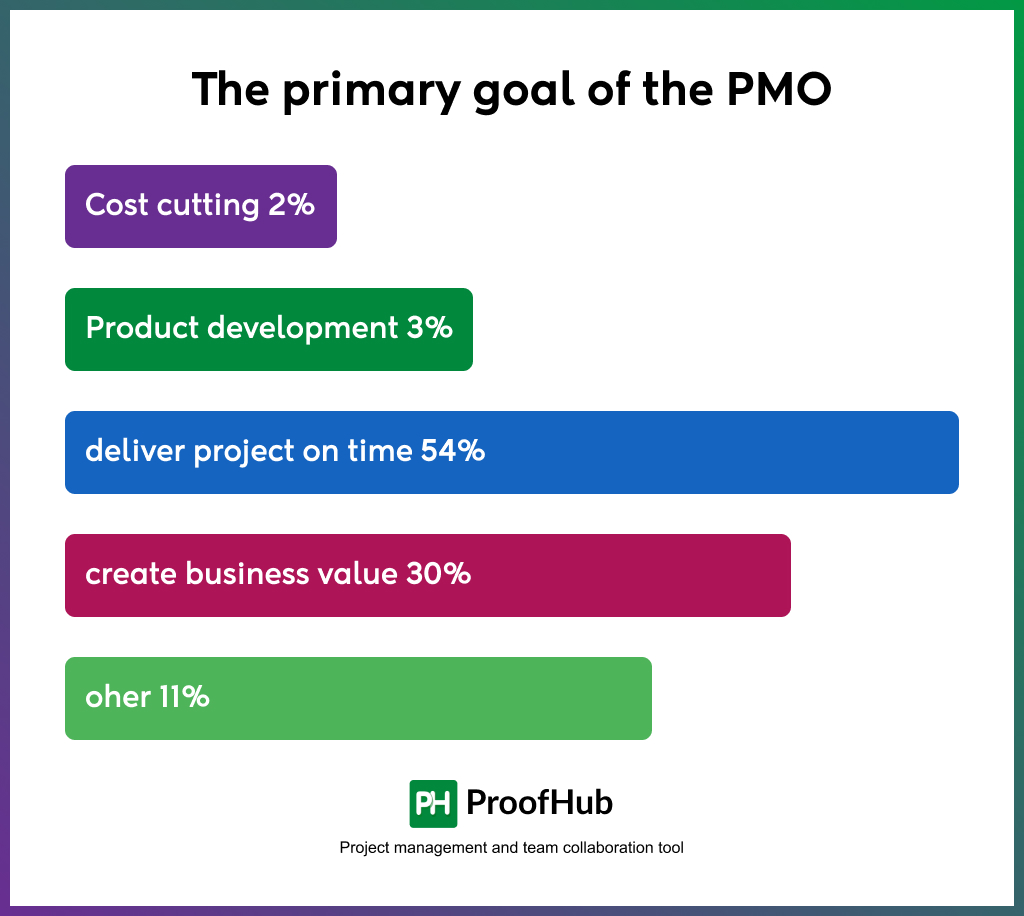
Project and Portfolio Management Landscape surveyed that almost half of PMOs are subject to maintaining operational work and driving strategic projects for business value.
Oftentimes, organizations are limited by how many projects can be done, requesting the question, “Are we doing the right projects?” To be effective, for instance, a portfolio manager should understand what project management is.
Thus the portfolio manager should ask the right questions of the program and project managers and interpret the information most effectively.
Inter-relationship of Portfolio Management, Program Management, and Project Management to Drive Strategic Objectives
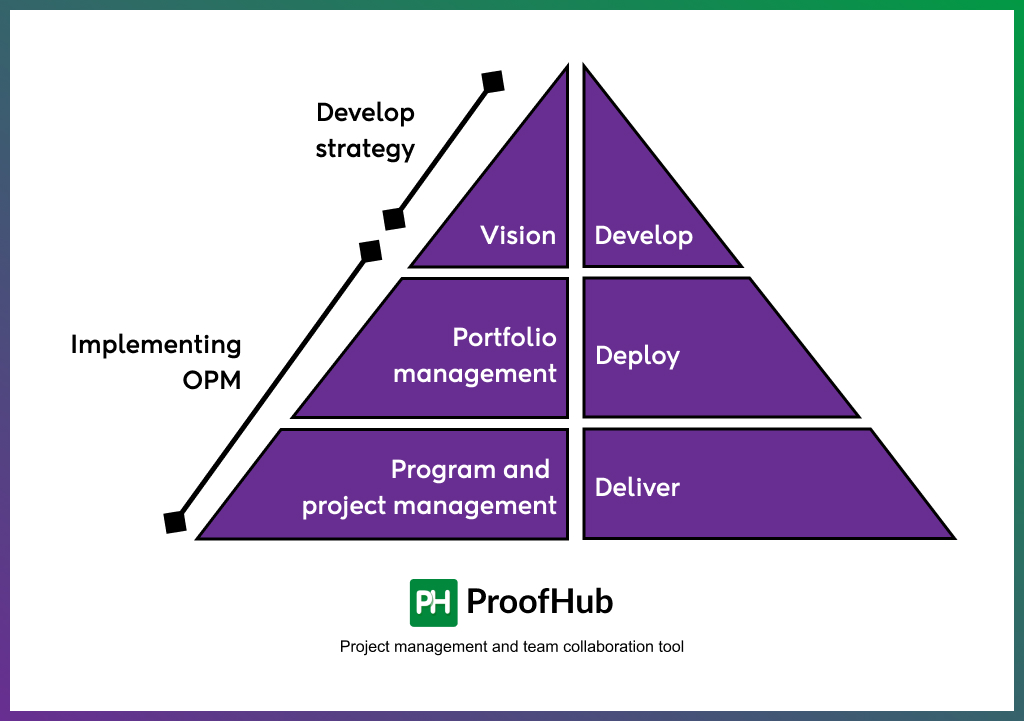
What is the role of a project portfolio manager?
There are many roles and responsibilities tied to the title of a “project portfolio manager”. As a project portfolio manager or PPM, you are responsible for overseeing the many aspects of a project, including planning, development, implementation, etc.
A PPM is also responsible for ensuring that only the best practices, solutions, principles, and standards are used during the project life cycle. Throughout the project lifecycle, the PPM develops, establishes, maintains, and collaborates standards to ensure that project efforts meet the defined expectations within the desired time and cost.
How do you build a project portfolio management process?

The project portfolio management process usually involves a step-by-step process that includes:
Inventory
- Identify strategic objective
- Identify all project and organization objective, budget, project attributes, and priorities
- Categorize projects
- Identify gating projects
- Map projects to strategic goals
Analyze
- Establish metrics
- Summarize project schedule
- Organize business values, objective, etc.
- Classify and organize projects
- Finalize gating process
Align
- Eliminate redundancies
- Prioritize
- Balance resources
- Mitigate risks
- Align projects with goals
Manage
- Delay, cancel and reschedule projects
- Cancel contracts
- Revise project budgets
- Initiate new projects
- Launch the portfolio projects
So, now that you know why do we need project portfolio management for overall project success, as a responsible team or project manager, embrace the principles of the agile method for the success of the company’s projects.
What are project portfolio management tools?
We’ve seen plenty of project portfolio management software in action, and these six are a cut above the rest. Mentioned below is our list of the best 6 PPM software and tools. Take a look.
1. ProofHub
ProofHub is a project management and project portfolio management software that simply focuses on simplifying work and it’s various stages. The software has a visually intuitive layout that helps managers and teams to keep work organized and delivered on planned.
With ProofHub, you can plan, collaborate, manage, track, and proof your projects and tasks. And thanks to its features like Gantt chart tool, you can understand dependencies between different tasks in a project, allocate resources smartly, and make sure that each team member’s work is aligned as expected.
2. Celoxis
Celoxis is a full-featured project portfolio management system that is intuitive and easy to use for teams of all sizes. With Celoxis, you easily allocate resources based on roles and availability.
Celoxis comes with a fully customizable portfolio dashboard and pre-built with common workflows that help with general management and risk management. Plus, the software solution is very adaptable to suit your organizational processes and fits within your budget.
3. Hive
Hive is project management, collaboration, and PPM tool with AI-based analytics, powerful integrations, flexible project views, and a lot more. The aim of this tool is to streamline work and workflow in one centralized platform.
Hive works for teams of varying sizes, from 10 people to 1,000. Moreover, it can be scaled up or down based on team needs and working style.
4. Clarizen
Clarizen is an enterprise-grade PM platform that’s great for managing large and simultaneous projects. A strong advantage of using Clarizen is that it has little to no learning curve.
Clarizen is great for centralized project and portfolio management, it helps to organize complex projects, automate workflows, track, manage, and prioritize change requests, and optimize resources in real time. Plus, it offers metrics for managing a budget, contracted revenue, planned benefits, ROI, and more. The platform also offers a reporting dashboard where you can display your data, as you like.
5. Wrike
Wrike has achieved international renown as a PM tool. With a focus on managing tasks and group collaboration, Wrike is similar to platforms like JIRA, Clarizen, or Asana.
Wrike’s resource management capabilities are powered by lots of live tracking, with a simplified overview of team workloads making it easy to track and balance resources. The Gantt chart feature also provides a visual timeline for setting dependencies and making real-time adjustments.
Time and budget tracking features allow for financial administration, and you can use Wrike’s report-building wizard to create real-time, interactive reports (with graphs, status updates, etc). There’s also a feature for scheduling notifications that it’s time for a regular report update or review.
6. Liquid Planner
Last, but definitely not least, we have Liquid Planner in our list of best project portfolio management solutions. For portfolio managers who are looking for a clean visual experience and a lot of options for customization, Liquid Planner is a great choice.
The platform is quite visual and minimalistic which makes it easy to learn, understand, and work. The platform is ideal for project portfolio management, but it also offers features for smart scheduling, advanced analytics, resource management, work collaboration, time-tracking, and more.
Benefits of project portfolio management
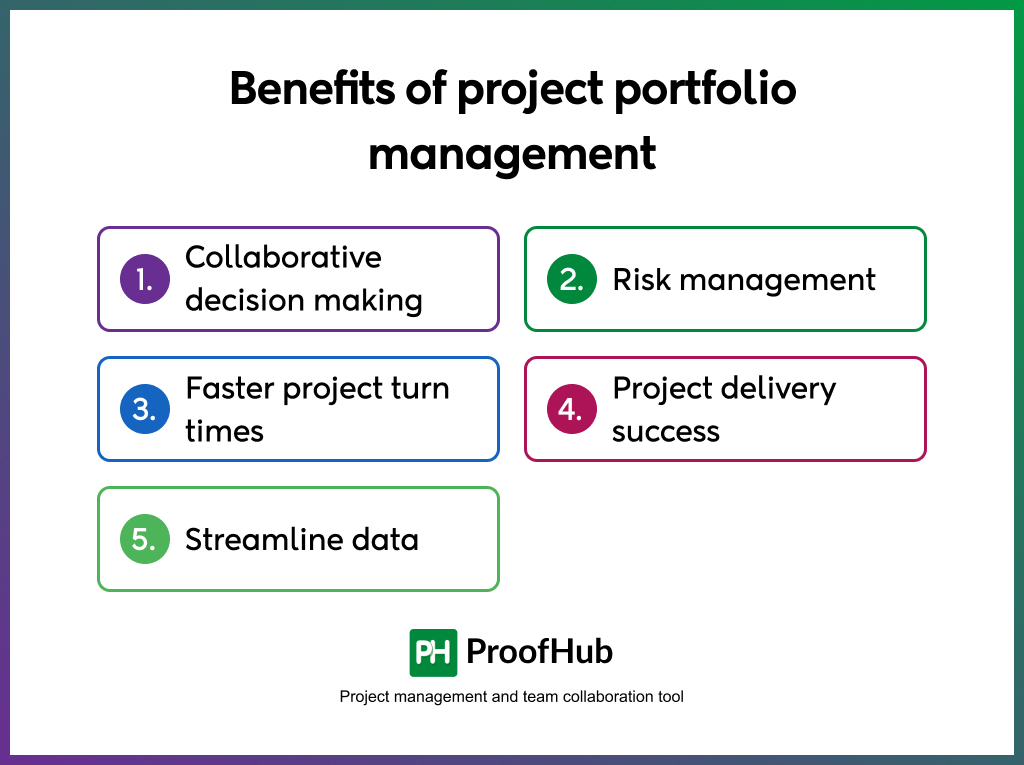
1. Collaborative decision making
To make good decisions, what you need is reliable data and making visibility crucial from various perspectives. For project managers and program managers, PPM can help stimulate a culture of collaboration when choosing projects. As project portfolio management highlights data-driven decision making, team members can collaborate which will strengthen relationships and promote trust over time.
2. Risk management
Every project requires a risk management plan blended with the scope of effort, budget, schedule, communication, and WBS. Companies must create portfolios that diminish any risks.
Portfolio project management tools provide the estimation capabilities to ensure that projects are estimated more accurately and the right resources are put into the right work at the right time to minimize any risks.
Read more: 11 Best Risk Management Software in 2025
3. Faster Project Turn Times
Portfolio project management has processes that allow team members to keep the work flowing and will always give an answer to “What do I do next?” typically increasing productivity.
4. Project Delivery Success
In recent years, the Project Management Institute (PMI) survey results show that successful PPM tools enable organizations to execute approximately 30% more projects and reduce project failure rates by up to 60%.
Project failure can be a result of factors such as cost overruns, schedule delays, poorly defined requirements, lack of strategy alignment, unresolved issues, and many such. PPM tools provide organizations with the functionality they need to more accurately deliver their projects.
5. Streamline Data and Increase Collaboration
Many businesses are still using Excel worksheets or manual tools for project management. Project transparency is important for proper decision-making and improved project performance. PPM gives the insight a project manager needs to get work done.
Pro-Tip: It is difficult to manage a project and program portfolio without the proper tools. Online PPM tools can help your team to manage a portfolio of projects. One of the most important PPM tools you should be using is ProofHub which offers accurate data across all projects in your portfolio.
Portfolio project management (PPM) features of ProofHub
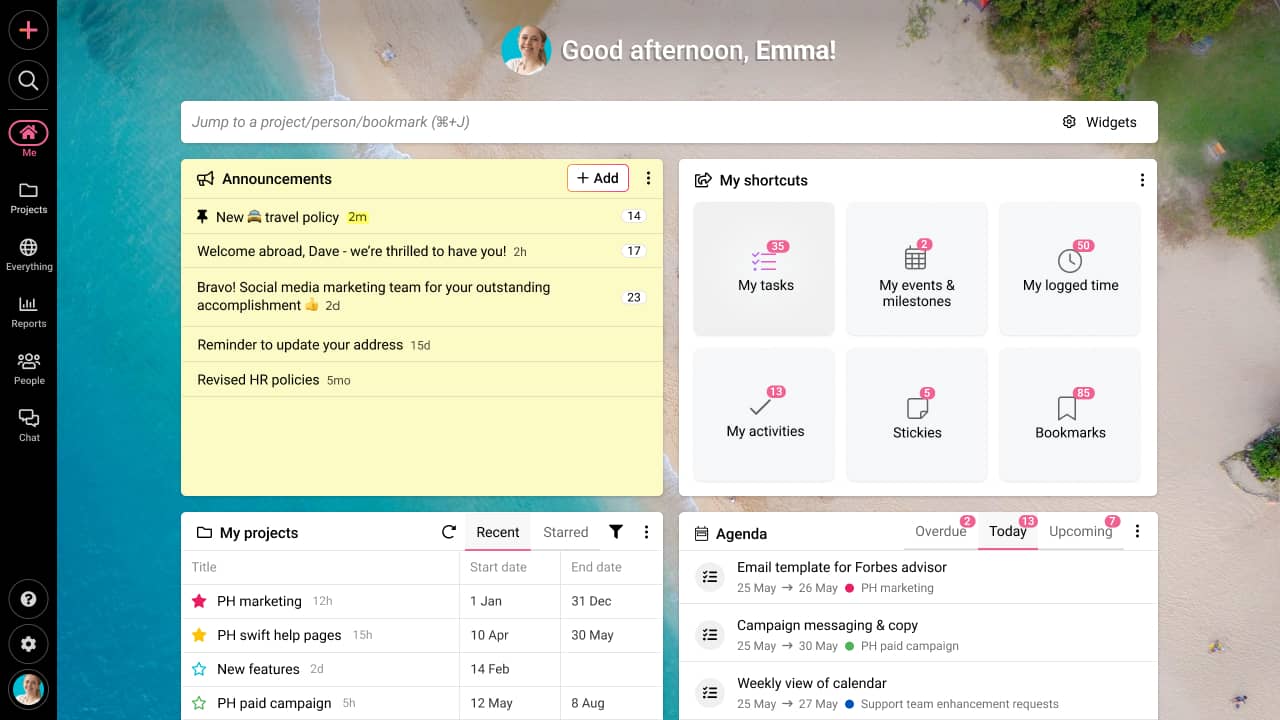
ProofHub, a project management software is one of the best portfolio management tools that help to keep your workspace streamlined and in one place. Below are some key features of ProofHub that can help project managers in being as productive as possible.
Price: ProofHub is available at $89 per month for unlimited users, unlimited projects, and 100GB storage.
Scalability: ProofHub offers scalable features and pricing to fit your needs and allow as many users as possible.
Mobile friendly: PPM software must be mobile friendly. With ProofHub Android and iOS, mobile app managers can update their teams with tasks, team activities, and more, anywhere and anytime.
Effective collaboration: A top project management software like ProofHub ensures collaboration to streamline engagement both within and across teams, organizations, and regions.
Centralized communication: With various team members on board from multiple locations, ProofHub ensures effective communication to deliver projects on time and within the budget.
When communication is streamlined through one central hub, you can:
- Connect and coordinate with all team members
- Track files and share data
- Provide real-time status update
- Solve problems faster
More transparency: With project management tools like ProofHub, it ensures more transparency and encourage teams to be more accountable towards the work.
Reporting: Customizable reports are available in all of the major dashboards and within projects.
Online Gantt Chart: Gantt charts are an intuitive way to visualize progress in projects and tasks, set dependencies, view critical paths, and track progress across the portfolio.
Start your free trial with ProofHub for ultimate project management. Hurry up!
Summary
Project portfolio management (PPM) software gives an opportunity to teams and organizations to make better decisions, to improve PMO performance, prioritize work, make a business strategy, and improve visibility into the portfolio of projects.

